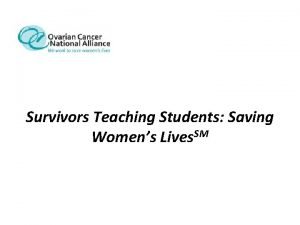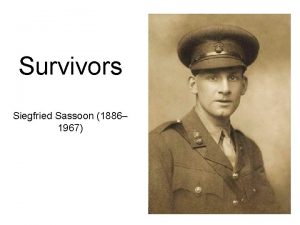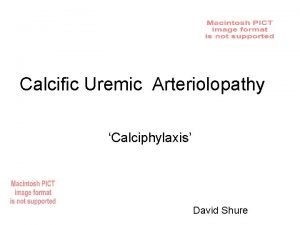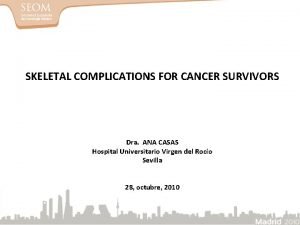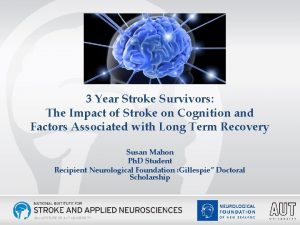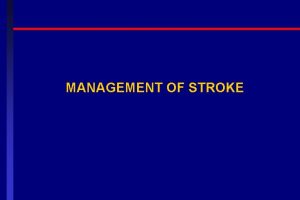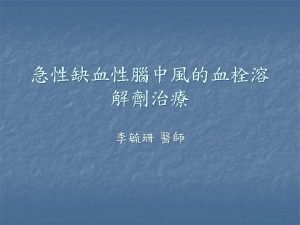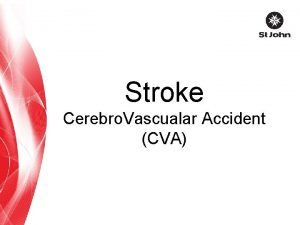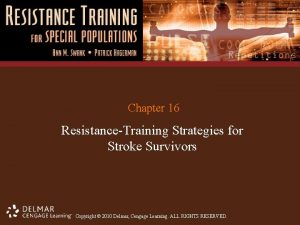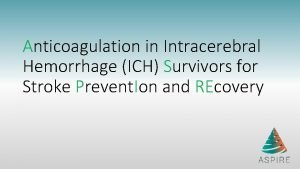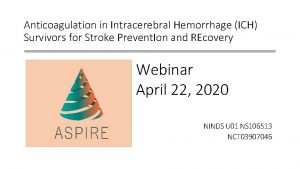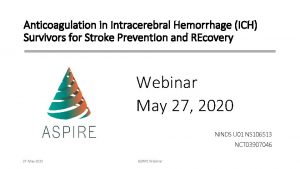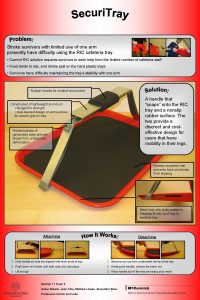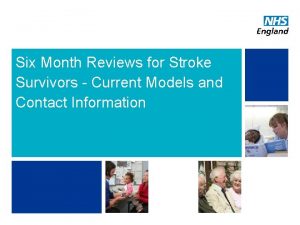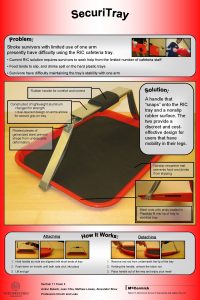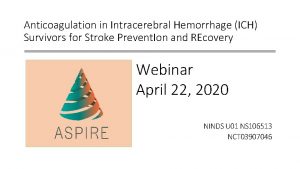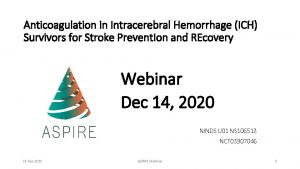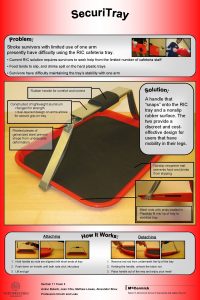3 Year Stroke Survivors The Impact of Stroke


















- Slides: 18

3 Year Stroke Survivors: The Impact of Stroke on Cognition and Factors Associated with Long Term Recovery Susan Mahon Ph. D Student Recipient Neurological Foundation : Gillespie” Doctoral Scholarship

Overview • Background • Current Epidemoloigcal Evidence • Objectives • Method • Results • Conclusion

Background Quality of life 7000 to 8000 people annually Caregivers Society Impact of cognitive deficits Cognitive impairment: 2/3 of survivors Independence Work Rehabilitation

Background • Cognitive Impairment post stroke: - occurs through dynamic changes in blood flow across widely distributed areas in brain - reperfusion of blood flow can improve cognitive performance in acute ischemic stroke – Deficits in cognition function vary – language, memory, executive function, processing speed, attention, and visuo-spatial function. • Existing data on cognitive outcomes within the stroke population is limited and varied * No previous population–based longitudinal study has been conducted in NZ, which has evaluated the long term effects of cognition and associated predictors

Current Epidemiological Evidence • Variability in findings u Poor study design (cross sectional) u small sample sizes u poor assessment methods (use of Mini Mental State Examination) which does not account for executive function) u short term follow up (usually within 1 year) Auckland Stroke Outcomes Study: ASTRO (2002 -2008) – Examined cognitive and functional outcomes at 5 years post stroke (n=307) – 30 -50% participants exhibited lower levels of neuropsychological functioning (Information processing speed and executive functioning) – Depression was significantly associated with functional outcomes but not neuropsychological impairment – Limitations use of cross sectional data, could not determine changes in cognition over time, did not examine fatigue, sleep, psychosocial factors

Current Epidemiological Evidence • South London Stroke Study 1995 -1998) – Examined the natural history of cognitive impairment following stroke over four years – Compared cognitively impaired participants (MMSE <24 n=248) with cognitively intact participants (MMSE 24 -30 N=397) – Followed up at 3 months, 1, 2, 3 and 4 years – Long-term cogntive impairment was associated with death or disability – Recovery was comprimised by visuospatial neglect and right hemispheric lesion (near-significant) – Limitations in (used mmse, lack of statistical power, study design)

Current Study • Extension of the Auckland Regional Community Outcomes Study ARCOS-IV (2010 to 2015) • Incidence and outcomes Study • Prospective, population-based stroke register • All new strokes, March 2011 -Feb 2012 (n=2090) • Auckland residents 16+ years (population 1. 3 million) • Demographic & clinical data collected, cognitive assessment and health-related outcomes - baseline, 1, 6, and 12 months • Collect cognitive and health-related outcomes at 3 to 4 years post stroke

Objectives Determine the prevalence and profile of cognitive impairment at 3 to 4 years post stroke Examine whether cognitive performance changes over time Identify the long term effects of stroke on cognition & associated factors that may influence recovery To determine whether we can predict how participants perform at 3 years; from screening at 28 days Awaiting analysis What does stroke look like in 3 to 4 year survivors?

Methods Overall Design: Quantitative longitudinal population based Population of Interest: Stroke survivors who participated in the ARCOS-IV study; who agreed to be contacted for further follow up (n =529) Consented participants completed face to face assessments Medical/health outcomes Health-related QOL Functional outcomes mood Cognitive assessments

Procedure Assessment 1: Completed Demographic, medical history, lifestyle, outcome measures, Montreal Cognitive Assessment Participants who agreed to be contacted for further research (n=529) Face to Face Mo. CA (n=248) 3 year follow-up assessments (n=277) Consent YES (n=277) Assessment 2: Cognitive Neuropsychological Battery, SDMT, CTMT, MWCST Analysis pending

OUTCOME MEASURES OUTCOME ASSESSMENT Demographic Information, medical history, education level, living status, employment, Mediation adherence (Morisky Medication Adherence Scale), lifestyle, rehabilitation, * Montreal Cognitive Assessment (Mo. CA)* 67 Cognitive Outcomes Neuropsychological Assessment Battery (NAB) 68 69 70 71 72 73 Modified Wisconsin Sorting Test (M-WST) 74 Digit Symbol Modalities Test (DSMT) 75 76 Comprehensive Trails Making Test (CTMT) 77 Stroke Subtype Quality of Life Level of Independence Level of Disability Fatigue Sleep Mood Quality of Life Social Support Community Integration * Denotes previously used measures for ARCOS-IV The Oxfordshire Community Stroke Project classification (OCSP)* Euro quality of life- 5 dimensions (EQ-5 D)* 62 Barthel Index (BI)* 61 Modified Rankin Scale (m. RS)* 60 Fatigue Severity Scale (FSS)*64 International Classification Sleep Disorders (ICDS)* 66 Hospital Anxiety Depression Scale (HADS)*78 Short Form- 36 (SF-36)*63 Social Support Questionnaire*79 Community Integration Questionnaire* 80

Results: Preliminary Findings Recruitment (n=529) Ethnicity Consented (281) Deceased (75) Too Unwell (23) 5% Moved(8) 3% 5% 2% NZ Europeans (237) Maori (14) Declined (98) Unable to contact (44) 8% Pacific (13) Asian (10) 19% 2% 4% 14% 53% 85% Other(5)

Variable Age Years Gender Marital Status Males Females Maori Pacific Asian Other European Married, Civil Inion or De facto Mean (SD) 73. 0 (13. 5) N (%) 146 (52. 3%) 133 (47. 7%) 14 (5. 0%) 13 (4. 7%) 10 (3. 6%) 5 (1. 8%) 237 (84. 9%) 176 (84. 9%) Employment Status Never Married Separated, divorced or widowed Employed 4 (1. 4%) 101 (35. 9%) 49 (17. 4%) Retired 205 (73. 0%) Unemployed TACS (Total Anterior Circulation Stroke) 27 (9. 6%) 22 (7. 8%) PACS (Partial Anterior Circulation Syndrome) LACS (Lacunar Syndrome) POCS (Posterior Circulation Syndrome 91 (32. 4%) 81 (28. 8%) 66 (23. 5%) IS 245 (87. 2%) ICH SAH Uncertain No Yes 16 (5. 7%) 19 (6. 8%) 1 (0. 4%) 230 (82. 4%) 49 (17. 6%) Range 3. 5 to 4. 5 years Average in Years 4. 0 Ethnicity Stroke Type (OCSP) Stroke Type (Class) Recurrent Stroke Times Since Stroke

Descriptive Statistics for Mo. CA Age Group (years) N Average Mo. CA Total Score /30 Score Range 0 -44 24. 6 6 -29 (n=8) 45 -64 (n=63) 21. 6 65 -74 (n=76) 21. 8 75+ 19. 2 Total 279 (n=132) 20. 7 83. 9% cognitive impairment Total N Average <=25 208 19. 5 >=26 40 26. 7 248 20. 7 * Cut off < 26 indicates Cognitive impairment

Cognition, Stroke Subtype and Classification Mo. CA and Stroke Sub. Type (OCSP) 25 Mo. CA and Stroke Classification 30 20 20 15 10 10 0 5 Ischemic 0 Intercerebral Haemorrhage TACI POCI LACI Uncertain *Total Anterior circulation strokes had lowest scores Subarachnoid Haemorrhage Uncertain

Multi-Regression Analysis Total Score Estimate Std Error P-value Intercept 28. 55 1. 86 <2 e-16 Age -0. 08 0. 03 0. 0045 Maori -2. 35 1. 23 0. 0570 Pacific -1. 63 1. 55 0. 2919 Asian/other 1. 42 1. 70 0. 4051 -2. 09 0. 91 0. 0221 unemployed -1. 56 1. 13 0. 1696 Employment retired Status ² Total Mo. CA score was significantly associated with age (decreased with older age) and ethnicity (was lower in Maori vs. Europeans, borderline significant effect p = 0. 0570) and lower in retired vs. employed.

Conclusions • Cognitive impairment is prevalent up to 4 years post stroke (84%) • Significantly associated with age, ethnicity and employment status • Cognitive rehabilitation is rarely implemented post stroke, identification of predictive factors vital to the development of effective intervention services to promote recovery following stroke • Final analysis will determine other factors which may influence long-term outcomes for stroke patients

Study Significance ² No previous population–based longitudinal study has been conducted in NZ, which has evaluated the long term effects of cognition and associated predictors ² Early detection of cognitive impairment could provide valuable prognostic information, assist in rehabilitation planning and allow therapies to be targeted to specific cognitive domains in the early phases of stroke
 Anterior stroke vs posterior stroke
Anterior stroke vs posterior stroke Survivors teaching students
Survivors teaching students Survivors siegfried sassoon analysis
Survivors siegfried sassoon analysis Calciphylaxis survivors
Calciphylaxis survivors Dra survivors
Dra survivors Australia desert animals
Australia desert animals School leavers poem
School leavers poem đại từ thay thế
đại từ thay thế Sơ đồ cơ thể người
Sơ đồ cơ thể người Quá trình desamine hóa có thể tạo ra
Quá trình desamine hóa có thể tạo ra Các môn thể thao bắt đầu bằng tiếng đua
Các môn thể thao bắt đầu bằng tiếng đua Cong thức tính động năng
Cong thức tính động năng Hát kết hợp bộ gõ cơ thể
Hát kết hợp bộ gõ cơ thể Dot
Dot Biện pháp chống mỏi cơ
Biện pháp chống mỏi cơ Vẽ hình chiếu đứng bằng cạnh của vật thể
Vẽ hình chiếu đứng bằng cạnh của vật thể độ dài liên kết
độ dài liên kết Gấu đi như thế nào
Gấu đi như thế nào Thiếu nhi thế giới liên hoan
Thiếu nhi thế giới liên hoan

